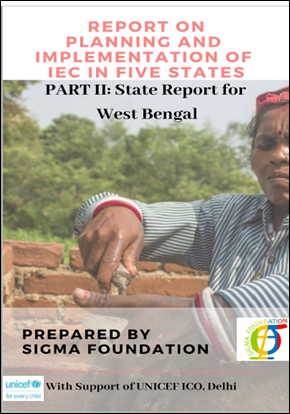Report on Planning and Implementation of IEC/SBCC Activities in West Bengal
Contributed By: Dr. M. N. Roy, Dr. Debasri Mukherjee, Dr. Sabari Bandyopadhyay, Mayuri Sen, Sohini Tarafdar, Poulami Basu, Nilanjana Mukherjee, Soumyajit Basu, Debojyoti MajumderMDWS requested UNICEF India Country Office (ICO) to study the status of preparation and implementation of IEC/SBCC plans of different states for the year 2018-19. UNICEF ICO agreed to support such assessment in Rajasthan. UNICEF ICO partnered with SIGMA Foundation, a ‘Not for Profit’ organization to take up the study. The approach adopted for the study involved analysis of the state and district IEC/SBCC plans for the year 2018-19 to review the plans and to assess various aspects of the processes of planning followed and implementation through field studies. Information was collected from different key officials through IDIs and various sections of the community through FGDs. 2 districts (Murshidabad and Purulia) were selected in consultation with the state governments and UNICEF state office keeping in mind the diversity within the state.
The report was shared with UNICEF ICO. It was found that the IEC/SBCC plan was formulated with a vision of reducing the disease burden of the rural population of West Bengal by achieving a cleaner environment. The components which were targeted were safe disposal of human and child faeces, improved personal hygiene, safe handling of water for drinking, and management of solid & liquid waste. The approach for the strategy involved finalization of the IEC/SBCC plans after consultation with the districts followed by the development of various IEC frameworks and prototypes. It also included Dip Stick studies for assessing the Knowledge, Attitude and Practice (KAP) related to sanitation, capacity building of various stakeholders, extensive use of mass and social media. Different tools including mass media, social media, print media, mid-media, community triggering (CAS) and orientation workshops used as channels of communication. Scripts, songs, messages, visual display and direct interaction with the people were used as the main tools. All the messages had specific extent of focus and targets.

